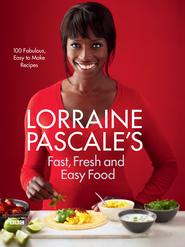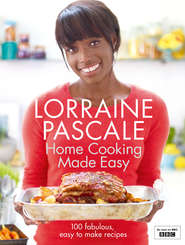По всем вопросам обращайтесь на: info@litportal.ru
(©) 2003-2024.
✖
Baking Made Easy
Настройки чтения
Размер шрифта
Высота строк
Поля
Dust two large baking trays with flour.
Put the flour, yeast and the 1½ teaspoons of salt into a large bowl and add enough of the water to make a soft but not sticky dough. Knead well for 10 minutes by hand on a lightly floured work surface or for 5 minutes if using an electric mixer fitted with a dough hook.
Divide the mixture into 12 equal portions, each weighing about 60g (2½oz). Roll them into balls, then place each ball on a floured surface and roll into a long sausage shape about 25 x 2cm (10 x 1in). For the best visual results make the sausage shape an even thickness.
I like to shape half of them into twists. Run a knife down the centre to split the dough, leaving a bit at the bottom uncut. Braid or plait the two halves over each other to give a twisted effect.
Place the breadsticks on the prepared baking trays, spacing them 4cm (1½in) apart.
Preheat the oven to 200°C (400°F), Gas Mark 6.
Cover the breadsticks loosely with oiled clingfilm, making sure it is airtight. Leave in warm place for 30 minutes, or until the breadsticks have almost doubled in size.
Remove the clingfilm and brush each breadstick with the extra-virgin olive oil. Sprinkle half the breadsticks with the sea salt and the remainder with the freshly ground black pepper. Bake on the top third of the oven for about 20 minutes, or until the breadsticks are lightly golden and feel firm to the touch. Remove the breadsticks from the oven and leave to cool on the baking trays.
Chorizo & thyme
Fougasse
Chorizo and thyme make a powerful flavour combination. Buy the big, thick chorizo sausage (either ready-to-eat or to be cooked), rather than slices, and cut into chunky pieces. A vegetarian in the house? Substitute the chorizo for a couple of handfuls of sun-dried tomatoes and sprinkle the top of the bread with some Parmesan cheese. Serves 6
500g (1lb 2oz) strong white bread flour, plus extra for dusting
2 tsp salt
2 tsp fast-action dried yeast
250–300ml (9–11fl oz) water
Leaves of 4 sprigs of fresh thyme
50g (2oz) ready-to-eat chorizo sausage, very finely chopped
Vegetable oil, for oiling
3 tbsp milk, for brushing
Preheat the oven to 200°C (400°F), Gas Mark 6. Dust a large baking tray with flour.
Put the flour, salt and yeast in a large bowl and mix together to combine. Make a large hole in the centre of the flour mix, then pour in the water, just enough to make a dough which is loose and easy to knead, but not too sticky. If it feels tight like Blue-tack then add more water. As you knead it, the dough will become less sticky, so if you can add all the 300ml (11fl oz) your loaf will be much lighter with a lovely open texture.
Knead the dough for 10 minutes by hand on a lightly floured work surface or for 5 minutes in an electric mixer fitted with a dough hook. Add the thyme and knead for a further 30 seconds, or until it is well combined. Put half the chorizo in the middle of the dough and then fold the edge around it to cover and knead it for an extra minute.
On a floured surface, shape the fougasse into a ball making sure the top of the ball is taught and smooth. Using a rolling pin, roll it out into a rough oval shape. Using a very sharp knife, or razor blade, carefully cut slashes in the loaf to look like a fern leaf, then with floured hands open up the slashes wide, as they will close up a lot when the bread is left to double in size.
Push the remaining chorizo into the top of the dough, then cover the dough loosely with oiled clingfilm (you may need several pieces). Leave to rise in a warm place until the dough has doubled in size.
Remove the clingfilm, brush the dough with milk and place in the oven. Throw a couple of handfuls of ice cubes in the bottom of the oven or spray the oven with water before closing. This will keep a crust from forming too quickly on the bread, which would prevent the bread from rising nicely. Alternatively, put a roasting tin with water in the bottom of the oven instead.
Bake for 30–35 minutes, or until the bread is well risen, a beautiful golden brown and smells wonderfully cooked. It will come off the tray once fully cooked too.
It is tough to top the taste of warm bread straight from the oven, slathered in oodles of good butter.
White Loaf
The process of making bread by hand is so rewarding. There is something therapeutic about kneading then shaping the loaf and leaving it in a warm place to grow. I confess I had a bread machine for a while, but I missed the comforting steps of the bread-making process, so I sold it online! This loaf has a soft crust and a perfectly pillowy centre. Angelic. Makes 1 loaf, two 23 x 12cm (9 x 4¾in) loaves or 12 rolls
560g (1¼lb) strong white bread flour, plus extra for dusting
1 tsp salt
1 x 7g sachet fast-action dried yeast
380ml (13fl oz) warm milk
1 squidge of honey
Vegetable oil or oil spray, for oiling
1 egg, lightly beaten, for glazing
Equipment
Two 23 x 12cm (9 x 4¾in) loaf tins or 1–2 large baking trays
Put the flour, salt and yeast in a large bowl. Make a hole in the centre and pour in the milk and honey. Mix well to combine, then knead for 10 minutes by hand on a lightly floured work surface or for 5 minutes in an electric mixer fitted with a dough hook. The dough may seem quite damp, but don’t be tempted to add more flour, as the wetter the dough the lighter the loaf! Just keep kneading and it will become less sticky.
If using loaf tins, divide the dough into 2 balls, smooth the tops and plop each one into a tin. Squish the dough down at the corners slightly and cover loosely with oiled clingfilm, making sure it is airtight.
If you are doing a free-form loaf or dinner rolls, dust the baking tray(s) with flour. Shape the dough into a ball on a floured work surface or divide into 12 rolls, then put on the baking tray(s) and cover loosely with clingfilm, making sure it’s airtight. Keeping the dough airtight encourages it to rise, but leaving the clingfilm loose gives the bread room to grow.
Leave to rise in a warm place until the dough has almost doubled in size.
Once the dough is well risen, carefully slash the top(s) with a sharp, serrated knife and preheat the oven to 200°C (400°F), Gas Mark 6. Brush the dough with the beaten egg and bake in the oven for about 30 minutes, or until the bread is golden brown and well risen. Using oven gloves, remove the loaves from the tins and check the undersides are cooked and the bases sound hollow when tapped. If still a little pale, place the bread back in the oven without the tins for 5–10 minutes.
Once cooked, leave the bread to cool on a wire rack. Serve with a good butter and our favourite yeasted spread!
Soda Bread
Perhaps the easiest bread to make by hand, with little kneading and no waiting around for it to rise. Treacle gives it an earthy taste, darkens the crumb and crisps up the crust. This recipe calls for buttermilk, available from bigger supermarkets; a homemade version can be made by putting lemon juice in regular milk and letting it sit for a few minutes. Makes 1 loaf
370g (13oz) plain flour, plus extra for dusting
130g (4½oz) wholemeal flour
1 tsp bicarbonate of soda
1 tsp salt







